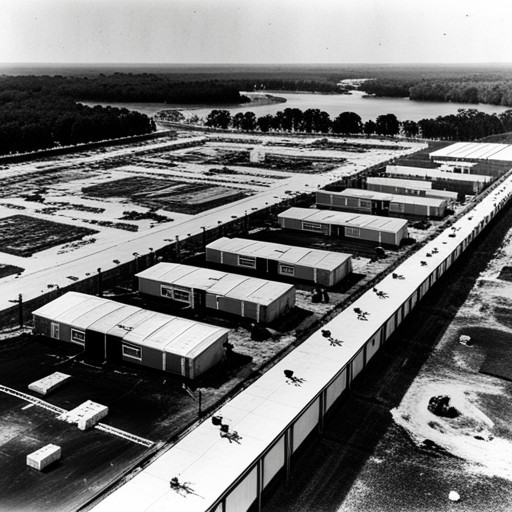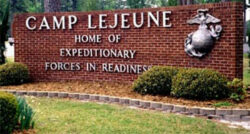From Inception to Infamy: The Journey of Camp Lejeune
This article traces the historical evolution of Camp Lejeune, a prominent United States Marine Corps base. It scrutinizes significant events, controversies, local community impact, and future prospects linked to this establishment.

By providing an objective analysis of the camp's journey from its inception to present-day infamy, this analysis aims to contribute substantially to military history literature while fostering a better understanding of the sociopolitical dynamics surrounding such institutions.
Key Takeaways
- Camp Lejeune was established in the early 1940s for military training during World War II, and its strategic location near the Atlantic Ocean and New River made it suitable for waterborne exercises.
- The camp underwent considerable development, transitioning from temporary wood-framed buildings to more permanent brick and concrete structures to accommodate the influx of personnel.
- Camp Lejeune is known for its training innovations and leadership development, including the introduction of 'Lejeune Leadership' to foster resilience and critical thinking skills.
- The contamination of drinking water with industrial solvents from 1953 to 1987 has led to health problems, lawsuits seeking compensation, and advocacy for stricter regulations to prevent similar incidents in other military bases.
The Early Days of Camp Lejeune

Established in the early 1940s, Camp Lejeune initially served as a vital training site for military personnel during World War II. Nestled within the coastal region of North Carolina, its geographic position offered strategic advantages that were pivotal to its establishment and subsequent development. The site's proximity to both the Atlantic Ocean and New River facilitated waterborne exercises while also providing easy access to shipping routes.
Lejeune's geography significantly influenced its architectural evolution. Initial constructions reflected practicality and necessity, with structures designed for functionality rather than aesthetics. As more troops arrived for training, there was an expansion in infrastructure to accommodate the influx of personnel which led to a blend of temporary wood-framed buildings with semi-permanent brick structures.
Post-war developments brought about changes in architectural designs at Camp Lejeune with an emphasis on long-term utility and durability. Building styles gradually transitioned from temporary constructions towards more permanent edifices that could withstand the harsh coastal weather conditions. Concrete became a prevalent construction material replacing wooden frames, ensuring a longer lifespan for facilities.
Furthermore, attention was given to creating spaces conducive to training purposes without compromising the safety standards or living conditions of military personnel. This is evident from the construction of improved barracks, administrative buildings, and recreational facilities over time.
The transformation in architecture at Camp Lejune reflects not only changing military needs but also advancements in building technologies throughout the decades. From humble beginnings during World War II through post-war transformations, Camp Lejune has evolved into a significant symbol of US military history.
Significant Events at Camp Lejeune
Noteworthy occurrences at the notable military base have played a crucial role in shaping its historical trajectory. Camp Lejeune has been a central hub for training innovations, with an emphasis on leadership development, denoted as 'Lejeune Leadership'. The implementation of these new approaches to training was pivotal in elevating the strategic capacity and effectiveness of the military personnel stationed there.
The evolution of 'Lejeune Leadership' represents one such significant event. This initiative was designed to foster resilience, critical thinking skills, and situational awareness among the ranks. Emphasizing ethical conduct and decision-making under pressure, it aimed to cultivate officers capable of leading under any circumstances.
Parallelly, training innovations were introduced that reshaped combat readiness exercises. Simulated battlefield scenarios were integrated into programs employing advanced technologies, thus bridging the gap between traditional methodologies and modern warfare tactics. These advances significantly enhanced troop preparedness for various global conflict situations.
Moreover, Camp Lejeune saw significant activity during periods of international tension and warfare. It served as a primary mobilization center during several wars including World War II, the Vietnam War, and Gulf Wars where comprehensive training regimes were implemented for soldiers before they were deployed overseas.
Controversies Surrounding Camp Lejeune

Controversies have emerged over time concerning this military base, particularly in relation to environmental issues and health concerns of its personnel. A notable point of contention has been the contaminated water within the boundaries of Camp Lejeune. Analytical data shows that from 1953 to 1987, individuals stationed at the base were exposed to drinking water tainted with industrial solvents such as trichloroethylene (TCE) and perchloroethylene (PCE). The contamination has been linked to an array of health problems, including several types of cancer and birth defects.
Lejeune lawsuits have since proliferated as affected parties seek compensation for their medical conditions. These legal actions are based on allegations that authorities neglected their duty to maintain a safe environment for camp residents and personnel. These lawsuits highlight the long-lasting repercussions of environmental neglect within military installations.
Attention should also be drawn to studies providing empirical evidence of the adverse effects caused by exposure to these harmful substances. Such research constitutes an essential component of these court cases, reinforcing claims brought forward by plaintiffs in Lejeune lawsuits.
Furthermore, policy changes have been suggested following revelations about contaminated water at Camp Lejeune. Advocacy groups argue that stricter regulations need implementation to prevent similar incidents from occurring in other military bases worldwide.
Impact on the Local Community

The local community surrounding the military base has also experienced profound impacts, particularly concerning health matters and economic repercussions. The presence of Camp Lejeune influences the socio-economic structure and development of the adjacent communities, as well as their public health landscape.
From an economic perspective, Camp Lejeune plays a vital role. It provides employment opportunities for civilians living nearby and boosts local businesses by attracting permanent and transient populations. This economic influence is manifested through increased consumer spending, improved infrastructure, and amplified real estate activities—contributing substantially to community development.
However, this positive Economic Influence coexists with some drawbacks. Health issues linked to water contamination have been a major concern over the decades, jeopardizing not only military personnel but also local residents who rely on shared water sources. Studies reveal an elevated incidence of certain diseases among these populations compared to national averages—an issue that has implications for local healthcare services and associated costs.
Moreover, there are indirect economic hardships suffered by those affected by such health conditions like loss of income due to illness or caring for sick family members. These hidden costs often go unnoticed when assessing the overall Economic Influence of military bases like Camp Lejeune on local communities.
Thus, it becomes evident that while Camp Lejeune contributes positively towards community development in terms of job creation and boosting business activity—the negative impact on public health cannot be overlooked. It underscores the need for comprehensive measures to safeguard community welfare beyond just economic factors.
Future Outlook for Camp Lejeune

Future prospects for this military base involve a thorough evaluation of its socio-economic and health impacts, necessitating stringent policies to mitigate adverse effects while enhancing its positive economic contributions. The proposed roadmap includes an emphasis on Lejeune's environmental initiatives, which aim at curbing pollution and promoting sustainable practices within the base.
Investments are being channeled into advanced waste management systems, energy-efficient infrastructure, and rehabilitation programs for the damaged local ecosystem. These initiatives reflect not only environmental responsibility but also economic prudence as they contribute to cost savings in the long run.
Concurrently, there is a recognition of the need to balance these green initiatives with continued military advancements. Modernization efforts have been scheduled in phased manners so as not to disrupt regular operations or compromise security protocols. Research into new technologies and strategic methods are prioritized, positioning Camp Lejeune at the forefront of military innovation.
However, it is crucial that such advancements do not exacerbate existing social or health issues among personnel or residents. Thus, comprehensive impact assessments should be regularly conducted. These evaluations would guide policy adjustments aimed at ensuring that both inhabitants' welfare and operational efficacy are optimized.
Frequently Asked Questions
What Kind of Training Programs Are Currently Offered at Camp Lejeune?
Camp Lejeune currently offers a diverse array of training programs, including combat preparation, vehicle operations, and specialized military roles. The impact of these programs is continuously evaluated to ensure optimal efficacy and skill development.
How Has the Military Technology Evolved at Camp Lejeune Over the Years?
The military technology at Camp Lejeune has evolved, marked by Lejeune's robotic advancements and next-gen weaponry evolution, reflecting a constant pursuit of innovation to enhance tactical efficiency and combat readiness.
Are There Any Notable Personalities Who Have Served at Camp Lejeune?
Numerous Lejeune alumni successes can be noted, including famous veterans like General James F. Amos and Sergeant Major Carlton W. Kent; their contributions to military service have greatly enhanced the reputation of Camp Lejeune.
What Are the Living Conditions Like for Military Personnel Stationed at Camp Lejeune?
Living conditions at Camp Lejeune include adequate housing facilities, comprehensive Family Support Services, and abundant recreational facilities. The base ensures a balanced lifestyle for military personnel through these amenities and support systems.
What Are the Environmental Conservation Efforts Being Undertaken at Camp Lejeune?
Environmental conservation efforts at Camp Lejeune include biodiversity preservation and strict water management measures. Strategies involve habitat restoration, species protection, rigorous water quality testing, and efficient use of water resources.
Conclusion
The history of Camp Lejeune is fraught with significant events and controversies. The base has imprinted a profound impact on the local community economically and socially.
Despite its infamy due to environmental issues, it continues to serve as an essential training ground for military personnel.
Future prospects suggest potential for improvement in environmental management, reaffirming its long-standing role in national security while aiming for a harmonious coexistence with the surrounding environment.




